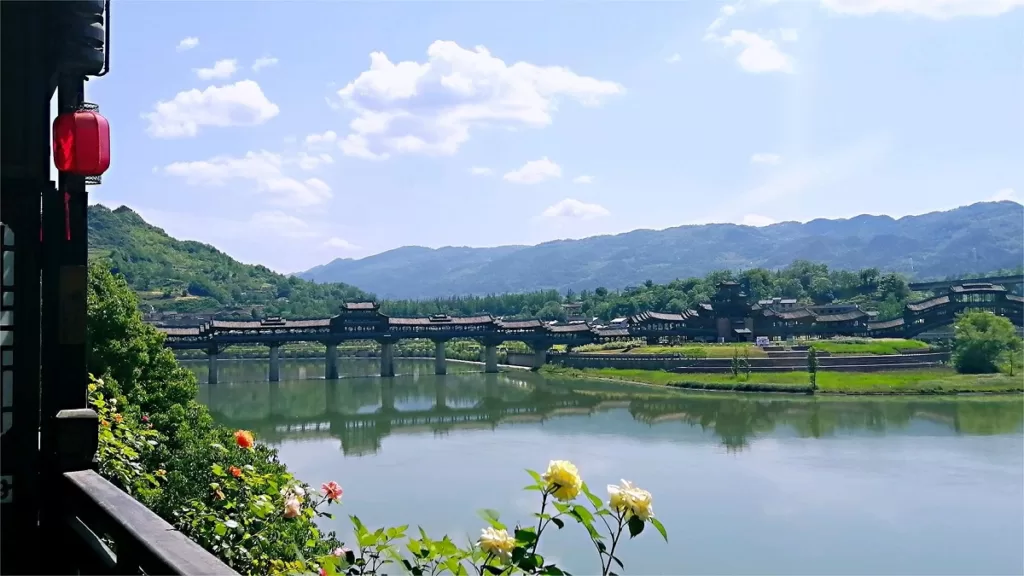Xiaonanhai National Geological Park (小南海国家地质公园), located in Qianjiang, Chongqing, covers an expansive area of 197 square kilometers, making it a breathtaking landscape that seamlessly integrates mountains, water, islands, and canyons. This high-altitude freshwater lake, surrounded by pristine natural beauty, also holds the distinction of being one of the most well-preserved ancient earthquake sites in China.
Originally named Xiaoying Lake, Xiaonanhai is a mountainous lake formed by a powerful natural event. In June 1856, during the sixth year of the Xianfeng reign of the Qing Dynasty, a significant earthquake with a magnitude of 6.25 and an intensity of 8 struck the region, triggering a massive landslide that blocked a creek. This natural disaster gave birth to a unique geological wonder—the Xiaonanhai Lake. The park experiences an average annual temperature of 15.4 degrees Celsius and an average precipitation of 1300 millimeters. However, it is also susceptible to various climatic calamities such as droughts, floods, hailstorms, continuous rain, low temperatures, and strong winds.
Table of Contents
- Basic Information
- Location and Transportation
- Highlights of Xiaonanhai National Geological Park
- Vlog about Xiaonanhai National Geological Park
- Other Attractions in Qianjiang District
Basic Information
| Estimated Length of Tour | Half a day |
| Ticket Price | 80 RMB |
| Opening Hours | 8.30 – 17.00 |
| Telephone Number | 0086-023-79856399 |
Location and Transportation
Xiaonanhai National Geological Park is situated in the town of Xiaonanhai, Qianjiang District, Chongqing, China. It is located within the Nanhai Village, near the border between Chongqing and Hubei provinces, approximately 30 kilometers north of the Qianjiang District. To get to Xiaonanhai National Geological Park:
- Arrive in Qianjiang District by plane, train, or long-distance bus.
- From Qianjiang, head to Qianjiang Bus East Station (黔江汽车东站).
- Transfer to a coach or bus bound for Xiaonanhai National Geological Park.
Highlights of Xiaonanhai National Geological Park
Chaoyang Temple Island

One of the most iconic features of Xiaonanhai National Geological Park is the Chaoyang Temple Island, named after the Chaoyang Temple situated on the island. Due to its butterfly-like shape, it is also known as “Butterfly Island.” Chaoyang Temple was initially constructed in 1764 during the 29th year of the Qianlong reign of the Qing Dynasty by a conscientious local official, Yang Yuncai. The temple complex originally consisted of a quadrangle courtyard with 60 rooms and was dedicated to various deities, including the South Sea Guanyin, the Twenty-Four Heavenly Deities, and the Eighteen Arhats. The name “Xiaonanhai” is believed to have originated from the worship of the South Sea Guanyin at Chao Yang Temple. Unfortunately, in the 1960s and 70s, the temple was destroyed by fire.
Other Islands

Apart from Chaoyang Temple Island, there are other captivating islands within the park. Niu Bei Island (Cow Back Island) is the largest of them all, covering approximately 8.33 hectares. Its unique shape resembles a reclining cow with its head dipping into the water, making for a picturesque sight. The island is adorned with lush pine forests and winding paths, creating a serene and tranquil atmosphere. The Dao Qian Creek, situated at the back of the island, is as slender as a ribbon and exudes an enchanting charm. In contrast, Lao He Ping Island is the smallest among the islands of Xiaonanhai, with an area of only 0.57 hectares. It earned its name due to the frequent presence of long-beaked, grayish-white herons on the island.
Tujia Minority

Xiaonanhai National Geological Park is not only known for its natural beauty but also for the cultural heritage of the Tujia people who have made this region their home. The Tujia people are known for their communal way of life, with each family or clan residing in a “zhaizi,” a village named after the family or clan. The most distinctive architectural feature of the Tujia people is the “diao lou” or hanging house. These houses come in two main types: “quan diao” (full hanging) and “ban diao” (half hanging). The “quan diao” style is relatively rare, with the entire building suspended in mid-air. The “ban diao” style, on the other hand, is more common and consists of a few rooms resting on the ground while the corners and upper floors are supported by stilts.
Typically, the central room in the main building is reserved for ancestral worship, complete with an altar to pay homage to the gods and ancestors. It is not used for daily living but may have a hearth for welcoming guests or conducting wedding ceremonies. The main building serves as the living quarters for parents and elderly family members, while the two wings house the children and other family members. Surrounding the hanging houses are corridors with carved railings and ornate window decorations featuring motifs of birds, animals, flowers, and plants, symbolizing prosperity, longevity, and good fortune.
Moreover, the area under the hanging houses is often utilized for various purposes, such as pigsties, cattle enclosures, or storage spaces for grinding mills, firewood, and miscellaneous items. This unique architectural style adds to the park’s charm, offering visitors a glimpse into the rich cultural heritage of the Tujia people.






The visit lasted about 2 hours, and you can also take a boat ride. Since there were few people when we went, the total number of visitors was estimated to be no more than 30 people, even during the holidays! So I highly recommend everyone to go for a leisurely stroll. It’s especially suitable for those who want to relax with their families.